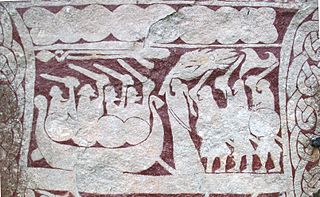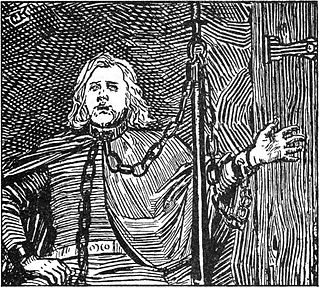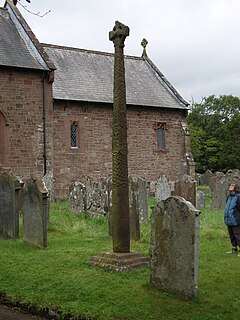
In Norse mythology, Hlín is a goddess associated with the goddess Frigg. Hlín appears in a poem in the Poetic Edda, compiled in the 13th century from earlier traditional sources, the Prose Edda, written in the 13th century by Snorri Sturluson, and in kennings found in skaldic poetry. Scholars have debated whether the stanza referring to her in the Prose Edda refers to Frigg. Hlín serves as a given name in Iceland, and Hlín receives veneration in the modern era in Germanic paganism's modern extension, Heathenry.

In Norse mythology, Eir is a goddess or valkyrie associated with medical skill. Eir is attested in the Poetic Edda, compiled in the 13th century from earlier traditional sources; the Prose Edda, written in the 13th century by Snorri Sturluson; and in skaldic poetry, including a runic inscription from Bergen, Norway from around 1300. Scholars have theorized about whether these three sources refer to the same figure, and debate whether Eir may have been originally a healing goddess or a valkyrie. In addition, Eir has been theorized as a form of the goddess Frigg and has been compared to the Greek goddess Hygieia.
In Norse mythology, Níðhöggr is a dragon/serpent who gnaws at a root of the world tree, Yggdrasil. In historical Viking society, níð was a term for a social stigma implying the loss of honor and the status of a villain. Thus, its name might refer to its role as a horrific monster or in its action of chewing the corpses of the inhabitants of Náströnd: those guilty of murder, adultery, and oath-breaking, which Norse society considered among the worst possible crimes. Níðhöggr nibbles on Yggdrasil's toes (roots)

In Norse mythology, Hildr is a valkyrie. Hildr is attested in the Prose Edda as Högni's daughter and Hedin's wife in the Hjaðningavíg. She had the power to revive the dead in battlefields and used it to maintain the everlasting battle between Hedin and Högni.

In Norse mythology, Búri is an early ancestor of the Æsir. Búri was licked free from salty rime stones by the primeval cow Auðumbla over the course of three days. Búri's background beyond this point is unattested, and he had a son, Borr, by way of an unknown process. Búri is attested in the Prose Edda, composed in the 13th century by Icelander Snorri Sturluson. The Prose Edda includes a quote from a 12th century poem by skald Þórvaldr blönduskáld that mentions the figure. Búri's mysterious origins are the subject of scholarly commentary and interpretation.
In Norse mythology, Vingólf is one of the buildings of the gods. It is described as the hall or hörgr of the goddesses and also as a place where righteous men and those slain in battle go after death. It is mentioned in the Prose Edda, Gylfaginning 3 and in the enigmatic poem Hrafnagaldur Óðins.

The term skald, or skáld, is generally used for poets who composed at the courts of Scandinavian and Icelandic leaders during the Viking Age and Middle Ages. Skaldic poetry forms one of two main groupings of Old Norse poetry, the other being the anonymous Eddic poetry.
Old Norse poetry encompasses a range of verse forms written in Old Norse, during the period from the 8th century to as late as the far end of the 13th century. Most of the Old Norse poetry that survives was preserved in Iceland, but there are also 122 preserved poems in Swedish rune inscriptions, 54 in Norwegian and 12 in Danish.

Haustlöng is a skaldic poem composed around the beginning of the 10th century. The poem is preserved in the 13th century Prose Edda, which quotes two groups of stanzas from it, and is attributed to the Norwegian skald Þjóðólfr of Hvinir. The poem describes mythological scenes painted on a shield given to the poet. In the stanzas that have come down to us two such scenes are described:

In Norse mythology, four stags or harts eat among the branches of the World Tree Yggdrasill. According to the Poetic Edda, the stags crane their necks upward to chomp at the branches. Their names are given as Dáinn, Dvalinn, Duneyrr and Duraþrór. An amount of speculation exists regarding the deer and their potential symbolic value.

The Gosforth Cross is a large stone Anglo-Saxon cross, in St Mary's churchyard at Gosforth in the English county of Cumbria, dating to the first half of the 10th century AD. Formerly part of the kingdom of Northumbria, the area was settled by Scandinavians some time in either the 9th or 10th century. It has gained reputation for its combination of Christian symbols with nordic symbols, being a tangible piece of evidence of the impact of the Christianization of Scandinavia.
Glúmr Geirason was a 10th-century Icelandic skald. He composed poems about King Erik Bloodaxe and his son King Harald Greyhide.
In Norse mythology, Njörun is a goddess attested in the Prose Edda, written in the 13th century by Snorri Sturluson, and various kennings. Scholarly theories concerning her name and function in the pantheon include etymological connections to the Norse god Njörðr and the Roman goddess Nerio, and suggestions that she may represent the earth or be the unnamed sister-wife of Njörðr.
In Germanic paganism, a vé or wēoh is a type of shrine or sacred enclosure. The term appears in skaldic poetry and in place names in Scandinavia, often in connection with a Norse pagan deity or a geographic feature. The name of the Norse god Vé refers to the practice. Andy Orchard says that a vé may have surrounded a temple or have been simply a marked, open place where worship occurred. Orchard points out that Tacitus, in his 1st century CE work Germania, says that the Germanic peoples, unlike the Romans, "did not seek to contain their deities within temple walls."

In Norse mythology, Herja is a valkyrie attested in the longer of the two Nafnaþulur lists found in the Prose Edda.

In Norse mythology, Geiravör is a valkyrie attested in the longer of the two Nafnaþulur lists found in the Prose Edda.
Vellekla is a partially preserved drápa composed in the late 10th century by the Icelandic skald Einarr Helgason skálaglamm. It is one of the two drápas he made for Hákon jarl. It speaks of the battle of Hjörungavágr and Hákon's campaign in Denmark, among other things.
The Royal Nordic Society of Antiquaries was founded in Denmark on 28 January 1825 by among others Carl Christian Rafn and Rasmus Rask. The company's aim is to promote Norse literature, history and archaeology. The society was first royal on 9 May 1828.












